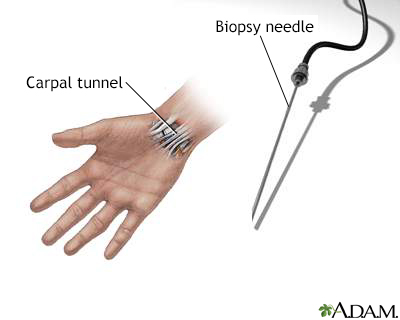Carpal tunnel biopsy
Biopsy - carpal tunnel
Carpal tunnel biopsy is a test in which a small piece of tissue is removed from the carpal tunnel (part of the wrist).
Images




I Would Like to Learn About:
How the Test is Performed
The skin of your wrist is cleansed and injected with medicine that numbs the area. Through a small cut, a sample of tissue is removed from the carpal tunnel. This is done by direct removal of tissue or by needle aspiration.
Sometimes this procedure is done at the same time as carpal tunnel release.
How to Prepare for the Test
Follow instructions for not eating or drinking anything for a few hours before the test.
How the Test will Feel
You may feel some stinging or burning when the numbing medicine is injected. You may also feel some pressure or tugging during the procedure. Afterward, the area may be tender or sore for a few days.
Why the Test is Performed
This test is often done to see if you have a condition called amyloidosis. It is not usually done to relieve carpal tunnel syndrome. However, a person with amyloidosis can have carpal tunnel syndrome.
Carpal tunnel syndrome is a condition in which there is excessive pressure on the median nerve. This is the nerve in the wrist that allows feeling and movement to parts of the hand. Carpal tunnel syndrome can lead to numbness, tingling, weakness, or muscle damage in the hand and fingers. Some of these injuries can be permanent, so it is important to have the condition addressed early.
Normal Results
No abnormal tissues are found.
What Abnormal Results Mean
An abnormal result means that you have amyloidosis. Other medical treatment will be needed for this condition.
Risks
Risks of this procedure include:
- Bleeding
- Damage to the nerve in this area
- Infection (a slight risk any time the skin is broken)
Related Information
Primary amyloidosisCarpal tunnel syndrome
References
Hawkins PN. Amyloidosis. In: Hochberg MC, Silman AJ, Smolen JS, Weinblatt ME, Weisman MH, eds. Rheumatology. 7th ed. Philadelphia, PA: Elsevier; 2019:chap 177.
Weller WJ, Calandruccio JH, Jobe MT. Compressive neuropathies of the hand, forearm, and elbow. In: Azar FM, Beaty JH, eds. Campbell's Operative Orthopaedics. 14th ed. Philadelphia, PA: Elsevier; 2021:chap 77.
BACK TO TOPReview Date: 9/20/2022
Reviewed By: C. Benjamin Ma, MD, Professor, Chief, Sports Medicine and Shoulder Service, UCSF Department of Orthopaedic Surgery, San Francisco, CA. Also reviewed by David C. Dugdale, MD, Medical Director, Brenda Conaway, Editorial Director, and the A.D.A.M. Editorial team.

Health Content Provider
06/01/2025
|
A.D.A.M., Inc. is accredited by URAC, for Health Content Provider (www.urac.org). URAC's accreditation program is an independent audit to verify that A.D.A.M. follows rigorous standards of quality and accountability. A.D.A.M. is among the first to achieve this important distinction for online health information and services. Learn more about A.D.A.M.'s editorial policy, editorial process and privacy policy. A.D.A.M. is also a founding member of Hi-Ethics. This site complied with the HONcode standard for trustworthy health information from 1995 to 2022, after which HON (Health On the Net, a not-for-profit organization that promoted transparent and reliable health information online) was discontinued. |
The information provided herein should not be used during any medical emergency or for the diagnosis or treatment of any medical condition. A licensed medical professional should be consulted for diagnosis and treatment of any and all medical conditions. Links to other sites are provided for information only -- they do not constitute endorsements of those other sites. © 1997- 2024 A.D.A.M., a business unit of Ebix, Inc. Any duplication or distribution of the information contained herein is strictly prohibited.
